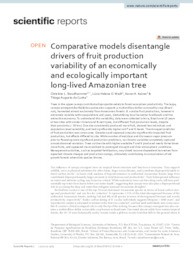Comparative models disentangle drivers of fruit production variability of an economically and ecologically important long-lived Amazonian tree.
Comparative models disentangle drivers of fruit production variability of an economically and ecologically important long-lived Amazonian tree.
Author(s): STAUDHAMMER, C. L.; WADT, L. H. de O.; KAINER, K. A.; CUNHA, T. A. da
Summary: Trees in the upper canopy contribute disproportionately to forest ecosystem productivity. The large, canopy-emergent Bertholletia excelsa also supports a multimillion-dollar commodity crop (Brazil nut), harvested almost exclusively from Amazonian forests. B. excelsa fruit production, however is extremely variable within populations and years, destabilizing local harvester livelihoods and the extractive economy. To understand this variability, data were collected in Acre, Brazil over 10 years at two sites with similar climate and forest types, but different fruit production levels, despite their proximity (~ 30 km). One site consistently produced more fruit, showed less individual- and population-level variability, and had significantly higher soil P and K levels. The strongest predictor of fruit production was crown area. Elevation and sapwood area also significantly impacted fruit production, but effects differed by site. While number of wet days and dry season vapor pressure prior to flowering were significant production predictors, no climatic variables completely captured annual observed variation. Trees on the site with higher available P and K produced nearly three times more fruits, and appeared more resilient to prolonged drought and drier atmospheric conditions. Management activities, such as targeted fertilization, may shield income-dependent harvesters from expected climate changes and production swings, ultimately contributing to conservation of old growth forests where this species thrives.
Publication year: 2021
Types of publication: Journal article
Unit: Embrapa Rondônia
Keywords: Amazonian forests, Amazonian tree
Observation
Some of Embrapa's publications are published as ePub files. To read them, use or download one of the following free software options to your computer or mobile device. Android: Google Play Books; IOS: iBooks; Windows and Linux: Calibre.
Access other publications
Access the Agricultural Research Database (BDPA) to consult Embrapa's full library collection and records.
Visit Embrapa Bookstore to purchase books and other publications sold by Embrapa.

